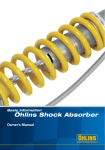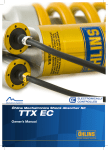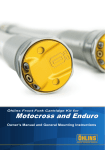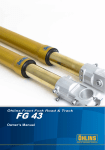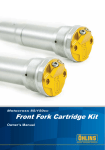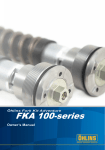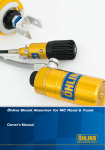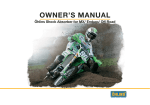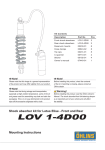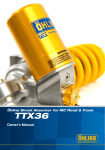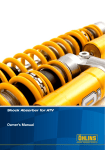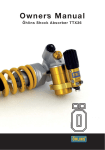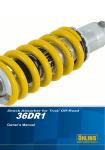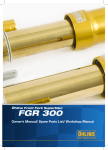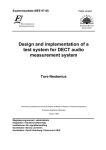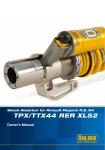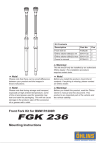Download Owner`s Manual
Transcript
Shock Absorber for snowmobile Owner’s Manual Öhlins Racing AB - The Story It was the 1970’s, a young man named Kenth Öhlin spent most of his spare time pursuing his favourite sport: motocross. A careful observer, Kenth’s attention was continually drawn to one specific detail motocross bikes had more engine power than their suspension could handle. It was not long before Kenth realised that better performance could be achieved by improved wheel suspension. Öhlins Racing was established in 1976, and just two years later the company won its first World Championship title. Despite being in the business for 30 years, the search for perfection and new functions is still the main focus of the company. Congratulations! You are now the owner of an Öhlins Shock Absorber. More than one hundred World Championships and other major world titles are definitive proof that Öhlins shock absorbers offer outstanding performance and reliability. Every product has gone through rigorous testing and engineers have spent thousands of hours, doing their very best to use every possible experience from our 30 years within the racing sport. The product that you now have in your possession is pure racing breed that is built to withstand. By installing this shock absorber on your vehicle you have made a clear statement… you are a serious rider with a focus on getting the maximal handling ability and outstanding feedback from your vehicle. Along comes the fact that your shock absorber will be a long lasting friend, delivering the very best of comfort and performance every time you go for a ride. Go explore! © Öhlins Racing AB. All rights reserved. Any reprinting or unauthorized use without the written permission of Öhlins Racing AB is prohibited. Printed in Sweden. Safety Precautions Note! Safety Symbols The shock absorber is a very important part of the vehicle and will affect the stability. Read and make sure that you understand the information in this manual and the mounting instructions before you use this product. If you have any questions regarding installation or maintenance please contact an Öhlins dealer. In this manual, mounting instructions and other technical documents, important information concerning safety is distinguished by the following symbols: The Safety Alert Symbol means: Warning! Your safety is involved. Öhlins Racing AB can not be held responsible for any damage to the shock absorber, vehicle, other property or injury to persons, if the instructions for installing and maintenance are not followed exactly. Warning! The Warning Symbol means: Failure to follow warning instructions can result in severe or fatal injury to anyone working with, inspecting or using the shock absorber, or to bystanders. Warning! This product was developed and designed exclusively for a specific vehicle model and shall only be installed on the intended vehicle model in its original condition as delivered from the vehicle manufacturer. Caution! The Caution Symbol means: Special precautions must be taken to avoid damage to the shock absorber. This product contains pressurized nitrogen gas (N2). Do not open, service or modify this product without proper education (authorized Öhlins dealer/distributor) and proper tools. Note! The Note Symbol indicates information that is important regarding procedures. After installing this product, take a test ride at low speed to make sure that your vehicle has maintained its stability. If the suspension makes an abnormal noise, or the function is irregular, or if you notice any leakage from the product, please stop the vehicle immediately and return the product to an Öhlins Service Centre. Note! When working on this product, always read the Vehicle Service Manual. This Manual should be considered a part of the product and shall therefore accompany the product throughout its life cycle. Contents Introduction1 Safety Precautions2 Contents3 Design 4 Functioning 5 Adjustments - General 6 Ride Height 7 Spring Preload11 Rebound and Compression13 Setting up the Snowmobile15 Inspection and Maintenance17 Design Most of Öhlins suspensions are a high pressure monotube type. The fluid is put under gas pressure and the gas and the fluid are kept apart by a separating piston. The piston is usually fitted in an external reservoir, connected by a hose (Fig. 4) or fixed directly on top of the shock absorber (Fig 3). In some models everything is fitted inside the main shock absorber (Fig 2). A few shock absorbers are of emulsion type, oil and gas mixed inside the shock absorber (Fig 1). Pressurisation of the fluid is made with nitrogen. The pressurisation prevents cavitation of the fluid and the shock absorbing action is therefore more even. The external reservoir also contributes to better cooling of the fluid, giving longer service life for the fluid as well as the components. All Öhlins shock absorbers for snowmobile also have a patented bronze ice scraper (Fig 5) on the piston shaft, preventing ice from damaging the seals and moisture from entering the shock absorber. Öhlins shock absorbers with external rebound adjustment have an integrated temperature compensation. As the temperature increases and the fluid flows more easily the flow is controlled accordingly. The shock absorbing effect is therefore independent of the temperature. The more advanced models permit individual adjustment of compression and rebound damping. Öhlins shock absorbers provide the possibility of adjustment, making them adaptable to most vehicles, riders and ranges of use. All of the shock absorbers with springs have adjustable preload of the spring action. 5 Shock absorber body Patented ice scraper (US Pat. no. 5584 368) 1 2 N 2 3 4 Separating Piston Fluid Emulsion Shock Absorber Internal Gas Reservoir External Piggyback Reservoir External Reservoir with Hose Connection Functioning Compression damping When movement of the snowmobile causes compression of the shock absorber, the fluid flows through the needle valve (combined compression and rebound valve) in the piston rod. If the velocity of the compression movement is high, i.e., in the case of rapid compression, this will not be sufficient and consequently the shims underneath the piston will open to allow for a greater rate of flow. The fluid that is displaced by the volume of the piston rod is forced into the external reservoir via a separate compression valve. The separating piston is displaced, thus increasing the gas pressure. Fluid is forced through needle valves at a low rate of flow (Fig 6) and through a number of orifices in the piston (Fig 7) at a high rate of flow. The flow through these orifices is regulated by shims (thin steel washers) that at high pressure are deflected to open for the fluid. On most models the needle valve can be adjusted from the outside. By altering the size of the shim-stack (Fig 8) (i.e. number, thickness, diameter) the characteristics of the damping action can be changed. This should only be done by an authorized Öhlins service workshop. 6 Rebound damping When the spring forces the shock absorber to extend again, the fluid flows back through the needle valve. The fluid flowing into the chamber is forced by the gas pressure back into the shock absorber via a separate non-return valve. If the piston velocity is high, the shims on top of the piston will also open to allow the fluid to flow through. 7 8 Stop washer Shim stack Rebound flow Compression flow Piston Adjustments - General Snowmobile traction qualities Most of the snowmobiles have a suspension with four shock absorbers, two in the front, one in the centre and one in the rear. Each shock absorber, with its spring, will distribute the weight of the snowmobile to the ground and can be seen as a “leg”. Since it is enough with three contact points or legs to carry the weight of the snowmobile without tipping, a fourth leg means the whole balance in the vehicle will change with very small adjustments. Think about it as adding a fourth leg in the centre of a three-legged stool. If this centre leg is just a little bit too long, one of the other legs will loose contact with the ground. On a snowmobile this example could translate into too low ski pressure and lost steering ability, if there is too much spring preload on the centre shock for instance. Changing to Öhlins suspension gives optimum performance only when both the front and the rear suspensions interact properly. Note! Always make sure that the basic setting made by Öhlins is intact. It is adapted to the specific make and model. Always begin with the basic settings recommended by Öhlins. Always make notes, adjust in small steps and make only one adjustment at a time. Adjustments should be made with two steps (clicks/ ½ turn (two-way compression damping) at a time. Most Öhlins shock absorbers for snowmobile are equipped with adjusters for spring preload, compression and rebound damping. Due to limited space in some vehicles it is not possible to have all adjusters in certain models. The three adjusters mentioned above, will be discussed in the following chapters. A deeper understanding for the different types of adjustments will give you a good knowledge of how you can get better performance from your Öhlins shock absorber. • Spring preload when adjusting the spring preload, you move the spring seat. This will lower or raise the ride height. • Compression damping controls the energy absorption when the shock absorber is being compressed, thus controls how easy the shock absorber compresses when you hit a bump. • Rebound damping controls the energy absorption when the shock absorber is being extended and, thus controls how fast the shock absorber returns to its normal position after being compressed. Start from the rear The suspension on your snowmobile can be divided into three parts; front, centre and rear suspension. It is advisable to start from the rear if you do not want to change all shock absorbers at the same time. Start with the rear shock absorber, then the centre and for the ultimate results, also the ski shock absorbers in the front. Basic set-up The Öhlins shock absorbers are intended to be a bolt on accessory and have very carefully tested settings. You can fine-tune the shock absorber with the adjusters. You can optimise the shock absorber for your weight, riding style and the riding conditions. Ride Height When adjusting the spring preload you move the spring seat. This will decrease or increase the initial spring force, which will lower or raise the vehicle rear ride height. Spring preload is fundamental for the function of the suspension. If the preload is incorrectly set, any other adjustments to the shock absorber will not help to get the intended performance from the suspension. Öhlins shock absorbers are delivered with the spring preload carefully set for a good balance in the vehicle with a 80 kg or 175 lb. rider. The spring preload affects the ride height, which on a snowmobile is the same as the “share” of the total snowmobile weight for each shock absorber to handle. This means that it affects the balance and performance of the snowmobile. Increasing the spring preload does not make the shock absorber stiffer, other than the initial force to compress the suspension from fully extended position. Since the suspension should be compressed as soon as you sit on the snowmobile, the suspension will not be stiffer after increasing the preload, only higher. Within reasonable limits, the spring preload does not affect bottoming. The spring stiffness and the hydraulic damping are the keys to controlling bottoming. A B A B Free spring length Installed spring length Shock absorber fully extended A - B = Spring Preload Spring Preload is the difference between the measures A and B. Ride Height Procedure Set the spring preload to the basic settings on the front and centre shock absorbers. Also, put the limiter straps for the centre shock absorber to the basic setting according to your vehicle service manual. Now you can start adjusting the rear shock absorber according to below. Then continue with the centre and front shock absorbers if needed. Check Rear Ride Height Torsion Spring Suspension Check the coupling device. Make sure the distances (x) are equal, as indicated in figure 9. If the distances are not equal, adjust the rear spring preload, figure 10. Check the coupling device again. 9 Rear ride height and Riding Comfort It is very important that the rear ride height is adjusted correctly. Due to the coupling device in the rear suspension, the rear ride height and riding comfort are linked together. If the ride height is not within the right range, the centre and the rear shock absorbers may start working parallel in unwanted situations, thus creating a too stiff suspension and a harsh ride. Note! These adjustments should be carried out on a flat surface. The most correct settings are performed indoors when the snowmobile is thawed out/ warmed. 10 Recommended Rear Ride Height When you sit on the snowmobile in riding position, wearing all your riding gear, we recommend the coupling adjuster free play to be equal in both directions, assuming that the coupling adjuster is in its standard setting. Increase or decrease the rear spring preload until you have reached the middle position of the coupling adjuster. If you carry heavy luggage, or a passenger, you must make the adjustments under the same conditions. Ride Height Torsion Spring Pro-Active Suspension Check the coupling device. The distance should be as indicated in figure 11. If the distance differs, adjust the rear spring preload, figure 12. Check the coupling device again. Yamaha Mono Shock Suspension Measure the spring with the suspension unloaded and fully extended (L1), figure 13. Measure the spring, vehicle on a flat surface with the rider on in full gear (L2). 11 L1 - L2 = Spring sag Recommended spring sag: 40 - 45 mm This will give a correct ride height. If you spring sag is: > 45 mm; Increase the spring preload (figure 14) < 40 mm; Decrease the spring preload (figure 14) 17 mm 2 3 / ‘‘ 12 13 L1 L2 14 Ride Height Yamaha Pro-Action Suspension Check the coupling device. Make sure the distances (x) are equal, as indicated in figure 15. If the distances are not equal, adjust the rear spring preload, figure 16. Check the coupling device again. 15 16 10 Spring Preload Front and centre Take the snowmobile for a test ride. Choose a short run of varying character, i.e. both long and sharp bends, with varying bumps. Stick to the same run and make only one adjustment at a time. Do you experience that any of the following behaviours are exaggerated? • The snowmobile under steers, wants to go straight instead of turning (low ski grip). • The snowmobile pitches from front to rear, fig 17. • The inner ski lifts when the snowmobile is accelerated out of corners. • The snowmobile is “wagging its tail” when letting off the throttle (coming in to corners for example), fig 18. Do you experience that any of the following behaviours are exaggerated? • The steering requires a lot of effort • The snowmobile front end feels nervous and it is difficult to hold a straight line. A possible cause: the centre shock absorber takes too much of the vehicle weight, which is the same as the front and the rear shock absorbers taking too little of the vehicle weight. Since the rear ride height is already decided by the rear spring preload, only the front and centre shock absorber springs preload remain to adjust. Warning! Too much ski pressure and/or no toe out will cause the sled to dart to each side, you will feel unsafe on straights. Check that the skis are toe out according to the vehicle manual. One of the causes for these behaviours could be that the front and rear shock absorbers take too much of the vehicle weight, which is the same as the centre shock absorber taking too little of the vehicle weight. Since the rear ride height is already decided by the rear spring preload, only the front and centre shock absorber spring preload remain to adjust. Try either of these changes Increase the preload on the front shock absorbers in 3 mm or 1/8 ‘‘ steps, or decrease the preload on the centre shock absorber in 2 mm or 1/12 ‘‘ steps. As a rule of thumb, the front ride height with rider should normally be 1/4 - 1/3 of the total travel, fig 19. Try either of these changes Increase the spring preload on the centre shock absorber in 2 mm or 1/12 ‘‘ steps or decrease the spring preload on the front shock absorbers in 3 mm or 1/8 ‘‘ steps. 17 18 11 Spring Preload Limiter straps If your vehicle has limiter straps or similar adjuster for the centre shock absorber, we advise to read your vehicle service manual for proper setting. 20 The limiter strap must limit the suspension travel before the shock absorber is fully extended. Note! The limiter straps protect the centre shock absorber from being torn apart. Very high tearing forces can occur, for instance if you jump with the snowmobile and land on the rear part of the rear suspension. Therefore the limiter straps must always be shorter than the shock, in fullly extended position. Figure 20. 19 Total suspension travel (T) T 3/4 - 2/3 of the suspension travel (H) H Ride height = T - H 12 Rebound and Compression If your snowmobile is equipped with rebound and compression damping, the damping is set with knobs and/or screws with a normal right-hand thread. By turning them clockwise the damping action increases and by turning them counter clockwise it will be reduced. Most of the adjusters have definite positions with a noticeable “click”, which makes it easy to count to the right setting. Rebound damping adjuster with screw. Rebound damping adjuster with knob. Compression damping adjuster with screw Note! If you can not feel the “clicks” on the rebound knob, the shock absorber must be inspected by an authorized Öhlins Service Centre. It could be due to low gas pressure or lack of oil. Compression damping adjuster with knob 13 Rebound and Compression High and Low speed Some models (called PRX) have separate adjusters for high and low speed compression. The low speed compression is adjusted in 25 steps. The high speed adjuster has a wide range without steps. The compression damping affects the energy absorption during compression and thus the force needed to compress the suspension. More compression damping will make the suspension firmer and make the vehicle run a little bit higher. On PRX shock absorbers, the X stands for high and low speed compression adjuster. • Low speed circuit: More damping will make the ride firmer and higher. • High speed circuit: More damping gives a firmer ride and more resistance against bottoming. The rebound damping affects the energy absorption during rebound and thus the force needed to extend the shock absorber. More rebound damping will make the extension slower, and vice versa. The external rebound adjustment actually also affects the compression damping by the ratio of approximately 90% rebound damping and 10% compression damping. High and Low speed Compression damping. High speed: Hexagon screw Low speed: Slotted centre screw Note! The damping forces are related to the speed between the shock absorber piston and the shock absorber body. The damping forces do not vary with the position of the piston inside the shock absorber. 14 Setting up the Snowmobile Start with the rebound damping If the snowmobile feels unstable, loose and rather bouncy, then the rebound damping should be increased. Begin by turning the adjuster knob 2 steps (clicks). Test run again and adjust one step back if it felt too hard and bumpy. If the snowmobile is hard and bumpy, especially over a series of bumps, then the rebound damping should be reduced. Turn 2 steps, test run and make necessary correction. For original rebound setting, see recommended Set-up data in the Mounting Instructions. Note! Always begin with the basic settings recommended by Öhlins. Always make notes, adjust in small steps and make only one adjustment at a time. Adjustments should be made with two steps (clicks)/ ½ turn (two-way compression damping) at a time. Setting Rebound and Compression By using the adjustment possibilities you can test by trial and error, and learn how they affect your snowmobile. Always begin by test riding the snowmobile with all adjustments at their basic setting. Choose a short run of varying character, i.e., long and sharp bends, hard and soft bumps. Keep to the same run and adjust only one setting at a time. Increase Rebound damping if the suspension feels: Reduce Rebound damping if the suspension feels: • • • • • Unstable Loose Bouncy 15 Hard Bumpy Setting up the Snowmobile Compression damping If the snowmobile feels soft, has low riding position and a tendency to bottom easily in long dips then the low-speed compression damping should be increased. Turn clockwise 4 clicks/ 1 turn and test run again. If this was too much, then turn back two steps (clicks)/ ½ turn. If the snowmobile feels harsh and has hard resilience, e.g., over changes in the ground surface, hen the high-speed compression damping must be reduced. Turn the adjuster ½ turn at a time. Test run and make necessary corrections. When you have sufficient feel of the snowmobile you can make further fine adjustments. It is feeling and experience that counts. Note! Ensure that the springs are properly preloaded before attempting to make any damping adjustments. A simple rule is that increased spring preload should be followed by an increase of rebound damping by 2 steps / ½ turn. When you feel that you have achieved an improvement, go back to where you started and check once more. Be observant of other relevant factors such as snow conditions, temperature, etc. Test run to make sure whether further fine adjustments should be made. Increase Compression damping if the suspension: Reduce Compression damping if the suspension feels: • • • • • feels soft feels low is bottoming 16 Harsh Hard Inspection and Maintenance Preventive maintenance and regular inspection reduces the risk of functional disturbance. If there is any need for additional service, please contact an authorized Öhlins Service Centre. 1 Cleaning Clean the shock absorber externally with a soft detergent. Use compressed air. Be careful that all dirt is removed. Lift the bump rubber and clean the area below. Keep the shock absorber clean and spray it with oil (WD40, CRC 5-56 or equivalent) after washing. Wipe off excessive oil with a cloth. 4 5 4 3 Caution! Never spray water directly into the adjuster knobs and/or the ball joints. 2 Inspection . Check ball joints for possible excessive play or stiction. . Check the piston shaft for leakage and damage. . Check the ice scraper for excessive wear. 4. Check the shock absorber body for external damage. 5. Check the external reservoir for damage that can restrict the floating piston from moving freely. 6. Check for excessive wear of rubber components. 7. Check the attachment of the shock absorber to the vehicle. 8. Check the hose equipped models for leaks in the hose and inlet plugs. 9. Check that the hose is properly attached and will not interfere with anything. 6 1 Lift the bump rubber and clean the area below. Note! The Öhlins shock absorber should only be filled with Öhlins Shock Absorber Fluid. Contact an Öhlins dealer for advise. Recommended Service Intervals Normal use: Once a year Racing use: Every 20 hours of operation Warning! Never change gas pressure. Special purpose charging equipment and access to nitrogen is required. Disposal Discarded Öhlins products should be handed over to an authorized Öhlins Service Centre or distributor for proper disposal. 17 www.ohlins.com Öhlins Owner’s Manual Shock Absorber for Snowmobile | Part No. 07230-02_3 | Issued 2009-06-15 | © 2009 Öhlins Racing AB Your Öhlins retailer: Öhlins Racing AB Box 722 SE-194 27, Upplands Väsby Sweden Phone: +46 (0)8 590 025 00 Fax: +46 (0)8 590 025 80 www.ohlins.com




















